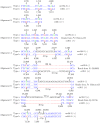Identification of Highly Variable Supernumerary Chromosome Segments in an Asexual Pathogen
- PMID: 27341103
- PMCID: PMC4920403
- DOI: 10.1371/journal.pone.0158183
Identification of Highly Variable Supernumerary Chromosome Segments in an Asexual Pathogen
Abstract
Supernumerary chromosome segments are known to harbor different transposons from their essential counterparts. The aim of this study was to investigate the role of transposons in the origin and evolution of supernumerary segments in the asexual fungal pathogen Fusarium virguliforme. We compared the genomes of 11 isolates comprising six Fusarium species that cause soybean sudden death syndrome (SDS) or bean root rot (BRR), and identified significant levels of genetic variation in A+T-rich repeat blocks of the essential chromosomes and in A+T-neutral regions of the supernumerary segments. The A+T-rich repeat blocks in the essential chromosomes were highly variable between F. virguliforme and non-F. virguliforme isolates, but were scarcely variable between F. virguliforme isolates. The A+T-neutral regions in the supernumerary segments, however, were highly variable between F. virguliforme isolates, with a statistically significant number (21 standard deviations above the mean) of single nucleotide polymorphisms (SNPs). And supernumerary sequence types and rearrangement patterns of some F. virguliforme isolates were present in an isolate of F. cuneirostrum but not in the other F. virguliforme isolates. The most variable and highly expressed region in the supernumerary segments contained an active DNA transposon that was a most conserved match between F. virguliforme and the unrelated fungus Tolypocladium inflatum. This transposon was absent from two of the F. virguliforme isolates. Furthermore, transposons in the supernumerary segments of some F. virguliforme isolates were present in non-F. virguliforme isolates, but were absent from the other F. virguliforme isolates. Two supernumerary P450 enzymes were 43% and 57% identical to their essential counterparts. This study has raised the possibility that transposons generate genetic variation in supernumerary chromosome segments by frequent horizontal transfer within and between closely related species.
Conflict of interest statement
Figures





Similar articles
-
Genetic architecture and evolution of the mating type locus in fusaria that cause soybean sudden death syndrome and bean root rot.Mycologia. 2014 Jul-Aug;106(4):686-97. doi: 10.3852/13-318. Epub 2014 Jun 2. Mycologia. 2014. PMID: 24891421
-
Genomic characterization of plant cell wall degrading enzymes and in silico analysis of xylanases and polygalacturonases of Fusarium virguliforme.BMC Microbiol. 2016 Jul 12;16(1):147. doi: 10.1186/s12866-016-0761-0. BMC Microbiol. 2016. PMID: 27405320 Free PMC article.
-
The genome sequence of the fungal pathogen Fusarium virguliforme that causes sudden death syndrome in soybean.PLoS One. 2014 Jan 14;9(1):e81832. doi: 10.1371/journal.pone.0081832. eCollection 2014. PLoS One. 2014. PMID: 24454689 Free PMC article.
-
Deciphering Pathogenicity of Fusarium oxysporum From a Phylogenomics Perspective.Adv Genet. 2017;100:179-209. doi: 10.1016/bs.adgen.2017.09.010. Epub 2017 Oct 31. Adv Genet. 2017. PMID: 29153400 Review.
-
The genomic organization of plant pathogenicity in Fusarium species.Curr Opin Plant Biol. 2010 Aug;13(4):420-6. doi: 10.1016/j.pbi.2010.04.004. Epub 2010 May 13. Curr Opin Plant Biol. 2010. PMID: 20471307 Review.
Cited by
-
Chromosomal scale assembly reveals localized structural variants in avian caecal coccidian parasite Eimeria tenella.Sci Rep. 2023 Dec 20;13(1):22802. doi: 10.1038/s41598-023-50117-0. Sci Rep. 2023. PMID: 38129566 Free PMC article.
-
A protoplast generation and transformation method for soybean sudden death syndrome causal agents Fusarium virguliforme and F. brasiliense.Fungal Biol Biotechnol. 2019 May 15;6:7. doi: 10.1186/s40694-019-0070-0. eCollection 2019. Fungal Biol Biotechnol. 2019. PMID: 31123591 Free PMC article.
-
Novel amplified fragment length polymorphism (AFLP) markers for typing medically relevant Fusarium and allied fusarioid genera.Fungal Syst Evol. 2025 Jun;15:79-96. doi: 10.3114/fuse.2025.15.03. Epub 2024 Oct 2. Fungal Syst Evol. 2025. PMID: 40170763 Free PMC article.
-
HPC: Hierarchical phylogeny construction.PLoS One. 2019 Aug 22;14(8):e0221357. doi: 10.1371/journal.pone.0221357. eCollection 2019. PLoS One. 2019. PMID: 31437210 Free PMC article.
-
Fluopyram Sensitivity and Functional Characterization of SdhB in the Fusarium solani Species Complex Causing Soybean Sudden Death Syndrome.Front Microbiol. 2018 Oct 1;9:2335. doi: 10.3389/fmicb.2018.02335. eCollection 2018. Front Microbiol. 2018. PMID: 30327645 Free PMC article.
References
-
- Raffaele S, Kamoun S. Genome evolution in filamentous plant pathogens: why bigger can be better. Nat Rev Microbiol. 2012;10: 417–430. - PubMed
MeSH terms
Substances
LinkOut - more resources
Full Text Sources
Other Literature Sources

